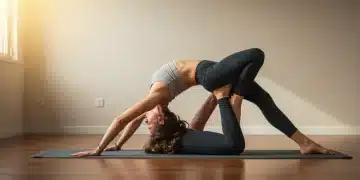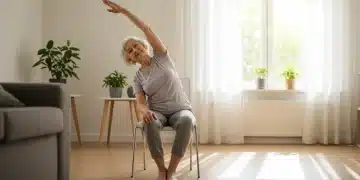Unlock Deep Relaxation: A Guide to Restorative Yoga
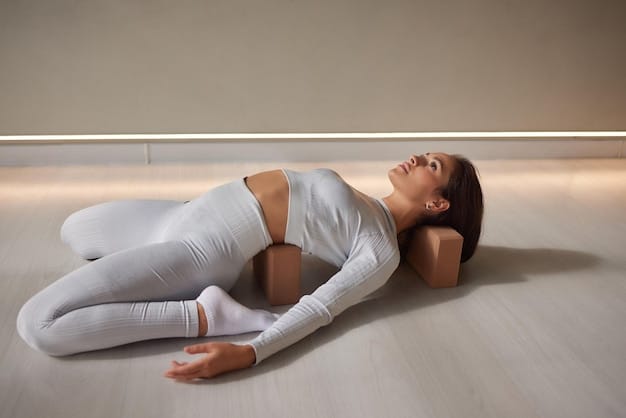
Discover the Power of Restorative Yoga: A Step-by-Step Guide to Deep Relaxation and Recovery explores gentle poses supported by props to induce profound relaxation, reduce stress, and assist the body’s natural healing processes, making it accessible to all levels.
In today’s fast-paced world, finding moments of deep relaxation can feel like a luxury. Discover the Power of Restorative Yoga: A Step-by-Step Guide to Deep Relaxation and Recovery offers a haven of tranquility, guiding you through gentle poses that promote profound rest and healing.
What is Restorative Yoga? Unveiling its Gentle Power
Restorative yoga is a unique practice that emphasizes relaxation and rejuvenation. It’s a passive form of yoga where poses are held for longer periods with the support of props, allowing the body to completely relax.
The Core Principles of Restorative Yoga
Unlike more active styles of yoga, restorative yoga is about surrendering to gravity and releasing tension without muscular effort.
How Restorative Yoga Differs from Other Styles
Restorative yoga stands apart from Hatha, Vinyasa, or even Yin yoga, prioritizing complete relaxation over stretching or strengthening. The use of props is key to achieving this deep state of rest.
- 😌 Gentle and passive poses
- ⏳ Longer holds (5-20 minutes per pose)
- 🧱 Extensive use of props (bolsters, blankets, blocks)
- 🧘 Focus on relaxation and stress reduction
Ultimately, restorative yoga is a powerful tool for cultivating inner peace and well-being, offering a much-needed antidote to the stresses of modern life. It’s about consciously choosing to slow down and allow your body and mind to recover.
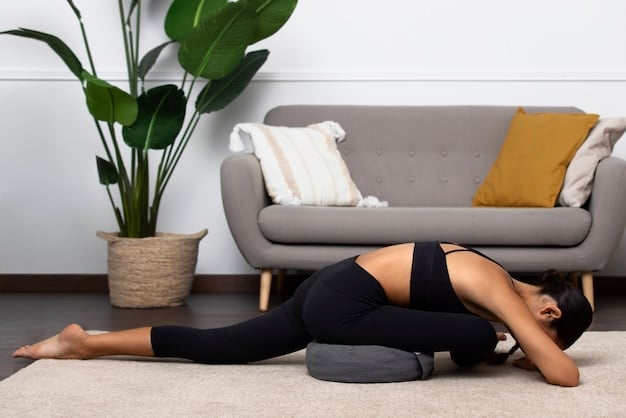
The Benefits of Restorative Yoga: More Than Just Relaxation
While relaxation is a primary goal, the benefits of restorative yoga extend far beyond simply feeling good. This practice can positively impact various aspects of your physical and mental health.
Physical Benefits
Restorative yoga can ease muscle tension, improve circulation, and lower blood pressure. The gentle poses encourage the body to release physical stress and promote deep healing.
Mental and Emotional Benefits
By activating the parasympathetic nervous system (the “rest and digest” response), restorative yoga reduces anxiety, improves sleep quality, and enhances overall mood. It creates space for emotional release and mental clarity.
- 🛡️ Reduces stress and anxiety
- 😴 Improves sleep quality
- 🩸 Lowers blood pressure
- 💪 Enhances immune function
The combined effect of these benefits makes restorative yoga a valuable practice for anyone seeking to improve their well-being, whether coping with chronic pain, managing stress, or simply desiring a deeper sense of calm.
Setting Up Your Restorative Yoga Space: Creating a Sanctuary
Creating a conducive environment is essential for a successful restorative yoga practice. A quiet, comfortable space free from distractions will enhance your ability to relax and fully immerse yourself in the experience.
Gathering Your Props
Essential props include bolsters, blankets, yoga blocks, and eye pillows. These supports allow you to fully relax into the poses without straining.
Creating a Calm Atmosphere
Dim the lights, play soft music, and use aromatherapy to create a soothing ambiance. Consider using candles or an essential oil diffuser to further enhance the relaxation.
- 🕯️ Dim lighting
- 🎶 Soft, calming music
- 🌸 Aromatherapy (lavender, chamomile)
- 🧸 Comfortable temperature
By transforming your space into a personal sanctuary, you create a powerful signal to your mind and body that it’s time to unwind and let go. The environment becomes an integral part of the restorative experience, facilitating deeper relaxation.
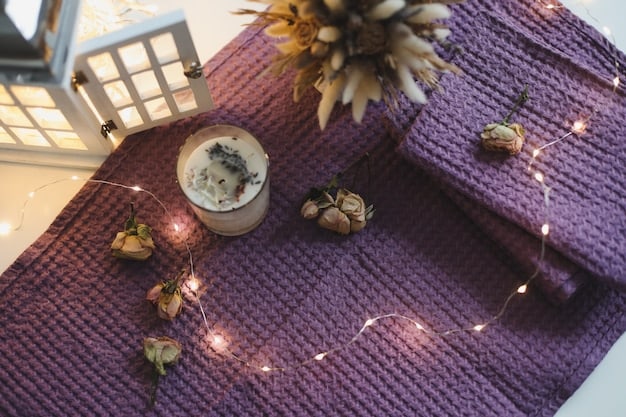
Step-by-Step Guide to Restorative Yoga Poses: Gentle Sequences for Beginners
Now, let’s explore some fundamental restorative yoga poses that are perfect for beginners. Each pose is designed to gently support the body and encourage deep relaxation.
Supported Child’s Pose (Balasana)
This variation of Child’s Pose uses a bolster to support the torso, allowing for complete relaxation of the back and shoulders. It’s a grounding pose that calms the mind and relieves stress.
Reclining Butterfly Pose (Supta Baddha Konasana)
In this pose, the spine is supported by a bolster while the soles of the feet are together, allowing the hips to gently open. It promotes relaxation, relieves mild depression, and can ease menstrual discomfort.
- 🧘♂️ **Supported Child’s Pose:** Soothes the mind and relieves stress.
- 🦋 **Reclining Butterfly:** Gently opens hips and eases tension.
- ⛰️ **Supported Bridge Pose:** Calms the brain and reduces anxiety.
- 🧱 **Legs-up-the-Wall Pose:** Drains stagnant fluid and relieves tired legs.
Remember to listen to your body and adjust the props as needed. The goal is to find a position where you can completely relax and release any tension. Each pose should be held for 5-20 minutes depending on your preference.
Tips for a Deeper Restorative Yoga Experience: Enhancing Relaxation
To maximize the benefits of your restorative yoga practice, consider these additional tips to enhance your relaxation and deepen your connection to the present moment.
Breath Awareness (Pranayama)
Focusing on your breath can deepen relaxation. Try practicing slow, deep breaths, inhaling through the nose and exhaling through the mouth. You can also try alternate nostril breathing (Nadi Shodhana) to balance the nervous system.
Mindfulness and Meditation
Use the time in each pose to practice mindfulness, observing your thoughts and sensations without judgment. You can also try a guided meditation to further quiet the mind.
- 🧘♀️ Focus on slow, deep breathing.
- 🧠 Practice observing thoughts without judgment.
- ✨ Engage in a short guided meditation.
- 🤫 Maintain silence and minimize distractions.
By incorporating these techniques, you can transform your restorative yoga practice into a profound experience of inner peace and self-discovery. With consistent practice, you can learn to access this state of deep relaxation more easily in your daily life.
Integrating Restorative Yoga into Your Life: Consistency is Key
The true power of restorative yoga lies in its consistent practice. Incorporating it into your routine, even for short periods, can have a cumulative effect on your well-being.
Creating a Regular Practice
Aim for at least one restorative yoga session per week, even if it’s just for 20-30 minutes. Schedule it into your calendar and treat it as a non-negotiable appointment with yourself.
Listening to Your Body
Pay attention to your body’s needs and adjust your practice accordingly. Some days you may need longer sessions, while others a short practice may be sufficient.
- 📅 Schedule weekly restorative sessions.
- 👂 Listen to your body’s needs.
- 🔄 Adjust prop support as necessary.
- 🤸 Combine with other forms of exercise.
By making restorative yoga a regular part of your life, you’ll cultivate a greater sense of balance, resilience, and inner peace, empowering you to navigate the challenges of life with greater ease and grace.
| Key Point | Brief Description |
|---|---|
| 🧘 Gentle Poses | Uses props for support and deep relaxation. |
| 😌 Stress Reduction | Activates the parasympathetic nervous system. |
| 😴 Improved Sleep | Promotes relaxation for better sleep quality. |
| 🧱 Essential Props | Bolsters, blankets, and blocks are fundamental. |
Frequently Asked Questions
Essential props include bolsters, blankets, yoga blocks, and an eye pillow. These supports allow you to fully relax into the poses without strain. Experiment to find what works best for you.
Generally, poses are held for 5-20 minutes, but you can adjust the time based on your comfort level. The key is to listen to your body and release any tension.
Yes! Restorative yoga is suitable for all levels of flexibility. The poses are gentle and supported by props, making them accessible to everyone, regardless of their physical abilities.
Aim for at least one session per week, but you can practice more often if desired. Even a short 20-30 minute session can provide significant benefits. Listen to what your body needs.
Restorative yoga is great any time, but particularly beneficial before bed, or during times of stress. Find a time when you can fully unwind and focus on relaxation.
Conclusion
Discover the Power of Restorative Yoga: A Step-by-Step Guide to Deep Relaxation and Recovery can contribute immensely to your overall well-being. By incorporating this gentle practice into your life, you invite deep relaxation, reduce stress, and promote healing. Prioritize self-care, and enjoy restorative yoga’s transformative effects!
